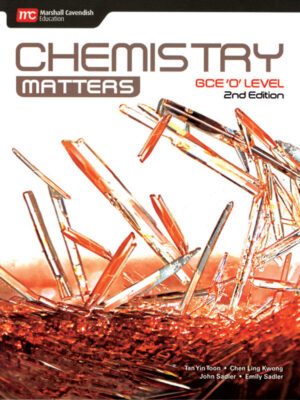Description
Chemistry A Level Paper 2 Topical Workbook and Past Papers Questions order new to old References of repeated questions added mark schemes included TABLE OF CONTENT UNIT 1: ATOMIC STRUCTURE 1.1 Particles In The Atoms And Atomic Radius 1.2 Isotopes 1.3 Electrons, Energy Levels And Atomic Orbitals 1.4 Ionisation Energy Answer Section 1.1 Particles In The Atoms And Atomic Radius 1.2 Isotopes 1.3 Electrons, Energy Levels And Atomic Orbitals 1.4 Ionisation Energy UNIT 2: Atoms, Molecules And Stoichiometry 2.1 Relative Masses Of Atoms And Molecules 2.2 The Mole And The Avogadro Constant 2.3 Formulas 2.4 Reacting Masses And Volumes (Of Solutions And Gases) Answer Section 2.1 Relative Masses Of Atoms And Molecules 2.2 The Mole And The Avogadro Constant 2.3 Formulas 2.4 Reacting Masses And Volumes (Of Solutions And Gases) UNIT 3: CHEMICAL BONDING 3.1 Electronegativity And Bonding 3.2 Ionic Bonding 3.3 Metallic Bonding 3.4 Covalent Bonding And Coordinate (Dative Covalent) Bonding 3.5 Shapes Of Molecules 3.6 Intermolecular Forces, Electronegativity And Bond Properties Answer Section 3.1 Electronegativity And Bonding 3.2 Ionic Bonding 3.3 Metallic Bonding 3.4 Covalent Bonding And Coordinate (Dative Covalent) Bonding 3.5 Shapes Of Molecules 3.6 Intermolecular Forces, Electronegativity And Bond Properties UNIT 4: STATES OF MATTER 4.1 The Gaseous State: Ideal And Real Gases And pV=nRT 4.2 Bonding And Structure Answer Section 4.1 The Gaseous State: Ideal And Real Gases And pV=nRT 4.2 Bonding And Structure UNIT 5: CHEMICAL ENERGETICS 5.1 Enthalpy Change, ΔH 5.2 Hess’ Law Answer Section 5.1 Enthalpy Change, ΔH 5.2 Hess’ Law UNIT 6: ELECTROCHEMISTRY 6.1 Redox Processes; Electron Transfer And Changes In Oxidation Number (Oxidation State) Answer Section 6.1 Redox Processes; Electron Transfer And Changes In Oxidation Number (Oxidation State) UNIT 7: EQUILIBRIA 7.1 Chemical Equilibria: Reversible Reactions: Dynamics Equilibrium 7.2 Bronsted-Lowery Theory Of Acids And Bases Answer Section 7.1 Chemical Equilibria: Reversible Reactions: Dynamics Equilibrium 7.2 Bronsted-Lowery Theory Of Acids And Bases UNIT 8: REACTION KINETICS 8.1 Rate Of Reaction 8.2 Effect Of Temperature On Reaction Rates And The Constants; The Concept Of Activation Energy 8.3 Homogeneous And Heterogeneous Catalysts Answer Section 8.1 Rate Of Reaction 8.2 Effect Of Temperature On Reaction Rates And The Constants; The Concept Of Activation Energy 8.3 Homogeneous And Heterogeneous Catalysts UNIT 9: THE PERIODIC TABLE: CHEMICAL PERIODICITY 9.1 Periodicity Of Physical Properties Of The Elements In Period 9.2 Periodicity Of Chemical Properties Of The Elements In Period 3 9.3 Chemical Periodicity Of Other Elements Answer Section 9.1 Periodicity Of Physical Properties Of The Elements In Period 9.2 Periodicity Of Chemical Properties Of The Elements In Period 3 9.3 Chemical Periodicity Of Other Elements UNIT 10: GROUP II 10.1 Similarities And Trends In The Properties Of The Group 2 Metals, Magnesium To Barium, And their Compounds Answer Section 10.1 Similarities And Trends In The Properties Of The Group 2 Metals, Magnesium To Barium, And their Compounds UNIT 11: GROUP 17 11.1 Physical Properties Of The Group 17 Elements 11.2 The Chemical Properties Of The Halogen Elements And The Hydrogen Halides 11.3 Some Reactions Of The Halide Ions 11.4 The Reactions Of Chlorine Answer Section 11.1 Physical Properties Of The Group 17 Elements 11.2 The Chemical Properties Of The Halogen Elements And The Hydrogen Halides 11.3 Some Reactions Of The Halide Ions 11.4 The Reactions Of Chlorine UNIT 12: NITROGEN AND SULFUR 12.1 Nitrogen And Sulfur Answer Section 12.1 Nitrogen And Sulfur UNIT 13: AN INTRODUCTION TO ORGANIC CHEMISTRY 13.1 Formulas, Functional Groups And The Naming Of Organic Compounds 13.2 Characteristics Organic Reactions 13.3 Shapes Of Organic Molecules; σ And π Bonds 13.4 Isomerism: Structural Isomerism And Stereoisomerism Answer Section 13.1 Formulas, Functional Groups And The Naming Of Organic Compounds 13.2 Characteristics Organic Reactions 13.3 Shapes Of Organic Molecules; σ And π Bonds 13.4 Isomerism: Structural Isomerism And Stereoisomerism UNIT 14: HYDROCARBONS 14.1 Alkanes 14.2 Alkenes Answer Section 14.1 Alkanes 14.2 Alkenes UNIT 15: HALOGEN COMPOUNDS 15.1 Halogenoalkanes Answer Section 15.1 Halogenoalkanes UNIT 16: HYDROXY COMPOUNDS 16.1 Alcohols Answer Section 16.1 Alcohols UNIT 17: CARBONYL COMPOUNDS 16.1 Alcohols Answer Section 16.1 Alcohols UNIT 18 CARBOXYLIC ACIDS AND DERIVATIVES 18.1 Carboxylic Acids 18.2 Esters Answer Section 18.1 Carboxylic Acids 18.2 Esters UNIT 19: NITROGEN COMPOUNDS 19.1 Nitrites And Hydroxynitriles Answer Section 19.1 Nitrites And Hydroxynitriles UNIT 20: POLYMERISATION 20.1 Addition Polymerization Answer Section 20.1 Addition Polymerization UNIT 21: ORGANIC SYNTHESIS 21.1 Organic Synthesis Answer Section 21.1 Organic Synthesis UNIT 22: ANALYTICAL TECHNIQUES 22.1 Infrared Techniques 22.2 Mass spectrometry Answer Section 22.1 Infrared Techniques 22.2 Mass spectrometry UNIT 23: MULTIPLE TOPICS Answer Section





Reviews
There are no reviews yet.